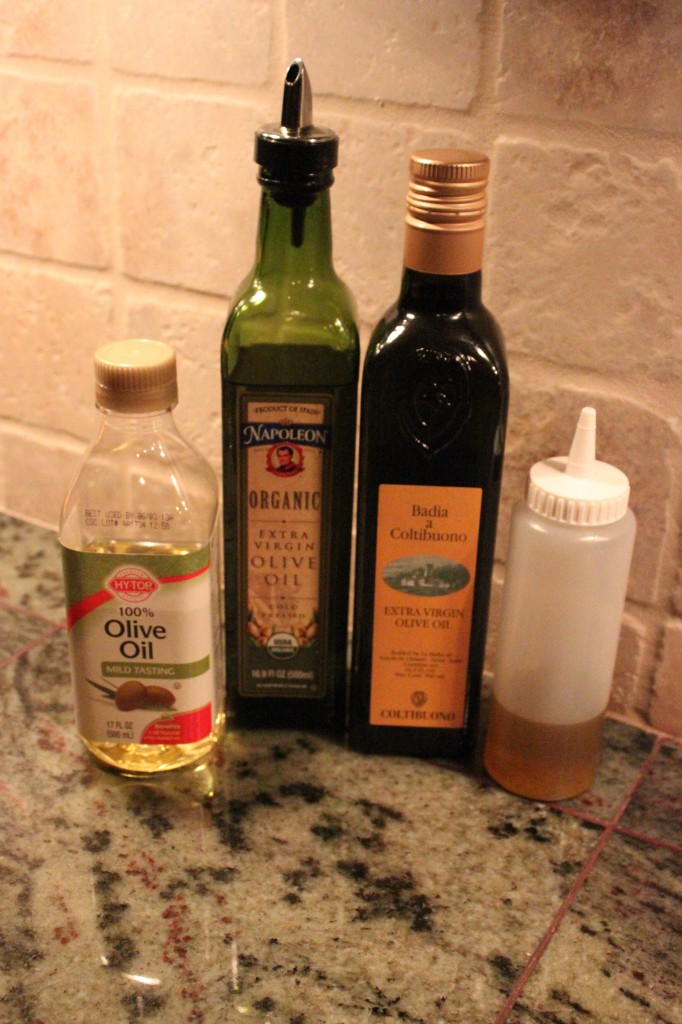Yesterday I posted about a cookbook that I’m currently just head over heels for, At Home with Michael Chiarello, and I’m just sure this is just one of many subsequent posts that will be inspired by this book, let alone this chef.
In the opening chapter, Chef Chiarello talks about items that should be in any well stocked pantry – things like dried pasta, canned tomatoes, balsamic vinegar, anchovies (he IS Italian after all) and not only do I agree, but I would say I generally walk this pantry talk. I totally agree that a well stocked kitchen is the key to having the flexibility to knocking out a great dinner on a moment’s notice. But there was one area I definitely fell short, and in an area I didn’t expect – olive oil.
I know the advantages of good olive oil and buy a good rated organic version to stock my shelf but Chef Chiarello recommends not having one, not two, but THREE levels of olive oil. First, a good-quality extra virgin olive oil for using in everyday cooked or uncooked dishes. Second, a special occasion unfiltered extra virgin olive oil utilized primarily for drizzling to finish a dish or as a special treat for dipping crusty French bread. And finally, the opposite end of the spectrum from the artisanal, the one most likely labeled simply “olive oil” – typically the oil that is extracted from olives that were first cold-pressed for the extra virgin offering, yielding a product that is lightly flavored and nearly colorless making it a perfect oil to infuse with other flavors.
Hopped up on inspiration I headed to the store to stock my apparently inadequate olive oil shelf. The inexpensive version was a no brainer, but there are certainly some expensive high end olive oils if your desire, and wallet, permit. I didn’t go crazy with this bottle of olive oil but did pop for one that was in the $25 range figuring that a little was going to go a long way.
I’m most interested in the infusing idea though and started with a recipe from the cookbook, “Infused” Basil Oil. The version of the recipe linked here stops a paragraph short of the hard part of the recipe as it’s published in the cookbook. After running it through a sieve, the second part was to strain the oil again, this time through flat-bottomed paper coffee filters. Let me tell you, it is painful how slow this oil drips through those coffee filters, and I must have changed the filters 6 times to keep the trickle going as they became clogged. I used the sieve to hold the propped up filters over a bowl so that I could go about my business because a watched oil was certainly not dripping any faster. After all the effort I ended up with the most beautiful green, wonderfully intense basil oil though. Worth the wait? Perhaps but you can bet I’ll be looking for a more efficient way to make this in the future.
After all that, perhaps you’re wondering how I used it. So far one of my favorites has been hot pan-popped popcorn (none of that lame microwave-popped stuff in this household!) tossed with the basil infused olive oil, Parmesan cheese, sea salt and a little grind of fresh black pepper. One bite so packed with flavor, and all the memory of the toil that went into the oil goes away, and I know I’ll be making this infusion again.


I noticed both of your better oils were Italian. May I recommend Greek too. Aptera (from the Co-op of course) is excellent for Greek Salad. It winds up going in everything else too. Mixed w/ Hare Hollow fig balsamic for bread dips, it’s heaven (vinegar from Healdsburg, CA – has to be shipped usually w/their pear champagne vinegar which is great alone). Just a suggestion…
Thanks Joyce! I’ll definitely look into the Greek varieties!